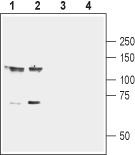Ephb1 Rabbit Polyclonal Antibody
Frequently bought together (1)
beta Actin Mouse Monoclonal Antibody, Clone OTI1, Loading Control
USD 200.00
Other products for "Ephb1"
Specifications
| Product Data | |
| Applications | FC, IF, WB |
| Recommended Dilution | WB: 1:200-1:2000; FC: 1:50-1:600 |
| Reactivities | Human, Mouse, Rat |
| Host | Rabbit |
| Clonality | Polyclonal |
| Immunogen | Peptide (C)RSQTNTARIDGLR, corresponding to amino acid residues 485- 497 of mouse EphB1. Extracellular, N-terminus. |
| Formulation | Lyophilized. Concentration before lyophilization ~0.8mg/ml (lot dependent, please refer to CoA along with shipment for actual concentration). Buffer before lyophilization: phosphate buffered saline (PBS), pH 7.4, 1% BSA, 0.05% NaN3. |
| Reconstitution Method | Add 50 ul double distilled water (DDW) to the lyophilized powder. |
| Purification | Affinity purified on immobilized antigen. |
| Conjugation | Unconjugated |
| Storage | Store at -20°C as received. |
| Stability | Stable for 12 months from date of receipt. |
| Gene Name | Eph receptor B1 |
| Database Link | |
| Background | Eph receptors are the largest family of receptor tyrosine kinases (RTKs). EphA receptors (EphA1-10) bind ephrinA ligands which are GPI-linked proteins and EphB receptors (EphB1-6) bind ephrinB ligands which are membrane protein with one transmembrane domain. Within each subfamily, interactions between receptor and ligand are promiscuous. In addition, Eph receptors can also bind ephrins from the other class. Forward and reverse signaling through Eph receptors is a unique characteristic to this RTK since ephrins are physically linked to the plasma membrane. Structurally, Eph receptors contain an extracellular ligand-binding domain, a transmembrane domain and an intracellular C-terminal domain responsible for intracellular signaling. Forward Eph receptor signaling involves autophosphorylation of the receptor via a tyrosine kinase domain, as well as phosphorylation of other proteins. Known effectors of the forward signaling include Src kinase and Ras/Rho GTPases. Much less is known about the reverse signaling mediated by Eph receptors. Besides from acting independently, Eph receptors can also signal in concert with other receptors. For example, Eph receptors cooperate with FGF receptor, NMDA ligand-gated ion channel and chemokine G-protein coupled receptor. Biological activities attributed to the Eph receptor-ephrin signaling module include establishing neuronal connections, mediating neuronal plasticity and repair following neuronal injury. Eph receptors may also have a role in the immune system. Eph receptors are expressed in the developing nervous system, and in the adult brain. It is also detected in the pancreas, intestine, bone and lymphocytes. In cancer cells, Eph receptors and ephrins are overexpressed. They are also implicated in neurodegenerative disorders like Alzheimerâ??s disease. |
| Synonyms | ELK; EPHT2; FLJ37986; Hek6; NET |
| Note | This antibody was tested in live cell imaging. Please see IF/ICC data for detail. |
| Reference Data | |
Documents
| Product Manuals |
| FAQs |
| SDS |
{0} Product Review(s)
0 Product Review(s)
Submit review
Be the first one to submit a review
Product Citations
*Delivery time may vary from web posted schedule. Occasional delays may occur due to unforeseen
complexities in the preparation of your product. International customers may expect an additional 1-2 weeks
in shipping.






























































































































































































































































 Germany
Germany
 Japan
Japan
 United Kingdom
United Kingdom
 China
China





